#it's semi biographical
Explore tagged Tumblr posts
Text
I think I had a wave of inspiration recently. I've been writing some stuff in my notes lately, and I think I have a good idea for a sitcom or family drama type series now. I don't know if I'll do anything with it in the future, but I want to share it. I don't want all my ideas to end up forgotten by the wayside (as they always end do end up that way). If anyone wants to see what I have written, just ask. I'd be welcome to share it.
#my ideas#tv show idea#it's semi biographical#in the sense that#I worked in some family stuff#that I've heard before irl#about my family#animated sitcom#tv shows#story ideas#ideas#asd#autism#autistic#adhd
5 notes
·
View notes
Text

Happy childhood memories <3
Unedited + bit of thoughts below

No one:
Me: So what about the Koskelas as kids 🥺🥺💙
I bet Ilmo would be the one who usually ended up pretty bruised from all the shenanigans he'd pull and trees he'd try to climb even if he was still too short😭
#my doodles#alan wake 2#koskela brothers#ilmo koskela#jaakko koskela#clothes lowkey inspired by the movie from peter franzén which is a semi biographical movie about his childhood#I also noticed that this is almost the exact same pose as the promo material for the koskelas#my posts#i usually dont draw children but i simply had to
17 notes
·
View notes
Text
i think i finally found a movie i saw for a while when i was like 12 and have been unable to identify since. i've been trying to google different descriptions every couple of years and always failed. until finally i just opened a japanese movie list on letterboxd, filtered them by decade and started opening movies that felt like they could be the one i was looking for. i can't wait to watch it in the next 6 years
#lang talks#the movie is Glory to the Filmmaker! by Takeshi Kitano#i only ever watched Fireworks by him. so i'm not sure i'll quite enjoy this semi auto-biographic surrealist parody of himself.#but maybe i could just watch some of his other movies first since i already wanted to do that
5 notes
·
View notes
Text
i didn’t really get fortnight but the minute it even vaguely clicks it’s on 24/7. like it’s so good now.
like “you’re wife waters flowers/ I wanna kill her” like the narrator has no idea about the wife, she knows nothing other than that she is in the way of an old flame. ‘she waters flowers’ like yeah that’s something that happens in the yard, where anyone can see her. the narrator is locked out of the neighbors life and is making no way in
and ‘my husbands cheating, I wanna kill him’ it’s almost the same. he’s not named he’s not important enough for that, the fact that’s he’s cheating isn’t even important now, just a justification to want to kill him. I wasn’t even mentioned in the song before the neighbors wife. the narrator just wants to get back to her ex.
#i wanna add more but i’m a little busy#i was really debating on whether to say Taylor or the narrator#like she is the muse#she does mostly semi biographical writing#let’s hope i didn’t horribly embarrass myself by utterly misunderstanding this song😅#correspondence to myself#taylor swift#TTPD#ttpd#the tourtured poets department#fortnight#might add more later#stick talks
3 notes
·
View notes
Text
A Star Is Born (1937) is actually vileeeee because the part where Esther looks at Norman’s photograph and echoes his last words to her (which by the way was a FANTASTIC scene because of how well and how devastatingly you can re-contextualize it in light of his suicide) but we as an audience don’t see what picture she’s looking at because of the recurring theme of privacy and forced lack thereof and she’s been hounded at his funeral and harassed repeatedly and had her veil torn off her and now at last her grief is private and even the audience doesn’t get to see?? SO well done it makes me mad
#it also made me tear up#which for myself I consider crying at media because I rarely actually cry#watched this movie for the first time today and I did not expect to like it as much as I did#og#a star is born#a star is born 1937#analysis#also I watched it right after watching funny girl and I really liked how clearly they conveyed the emotions between the two#how Norman struggles but still loves his wife was really refreshing after FG cause I was worried I’d accidentally#put on the same plot twice lmao#(to be clear while I didn’t enjoy FG as much it did what it was trying to do I’m not saying ASIB did what FG was attempting)#but also the narrative of husband upstaged who struggles but still evidently loves his wife so much is decidedly less common#so that in itself was refreshing#although I understand that FG is semi-biographical so they were working with the story they had#anyway. it’s a really nice movie I quite liked it
3 notes
·
View notes
Text
i would have saved him (john keats)
4 notes
·
View notes
Text
I’m watching too many world war 2 movies/series with my aunt and now I’m just obsessing over actors that are literally in nothing else. Tell me why they have the best intimacy, brotherhood, romance story lines.
#fffffffffff#fucking Sergeant Lena in the Pacific#I love you#I want her#I want to be her#and John Basilone?#baby#but fucking Lecky#my one and only#just let him be happy#I know these are real people in a semi biographical dramatic retelling#but also#these are characters
0 notes
Text
semi-related to my last reblog, a decent amount of biographical "information" we have on ancient and medieval figures, especially controversial ones, is basically like if it were 3035 and the only thing we knew about Ted Cruz was that his dad killed JFK, so it's frustrating 2 me when rehabilitations focus on "ok maybe they did that but it was ok" when it's just as likely that it didn't happen at all
90 notes
·
View notes
Text
LGBT literature of the 1860s–1910s. Part 5
After a long pause, the list is back! Here we have a couple of plays, accounts by two trans women, lesbian poetry, and more.
1. Despised and Rejected, by A.T. Fitzroy (Rose Allatini; 1918). A pacifist novel published during World War One? With gay and lesbian characters? Yes, that was sure to get people in trouble. Its publisher was fined and the judge called it “morally unhealthy and most pernicious”. So, Dennis is a young composer who hates violence and therefore refuses to go to war. He also suffers because he is a “musical man”, that is, gay, and loves Alan, art-loving son of a wealthy businessman. His friend Antoinette, meanwhile, is “strangely attracted” to a woman. Nevertheless, the two attempt to love each other. When the war begins, Alan appears in Dennis’ life again, and they try to avoid being sent to the front together. Alan also persuades Dennis to accept who he is. Edward Carpenter himself defended the novel, saying that “the book is also a plea for toleration of a very much misunderstood section of humanity”. Read online
2. Autobiography of an Androgyne, by Ralph Werther (1918). Ralph Werther, also known as Jennie June, wrote this autobiography for doctors, and it is very revealing. Being a New York fairy (male prostitute) and possibly a trans woman, they tell frankly about the city’s gay underworld of the early 20th century and their personal experience, which is sometimes too frank and dark perhaps, but all the more interesting. Read online
3. Poems by Mikhail Kuzmin. Kuzmin was not just the author of Russia’s first gay novel, but also a poet. Many of his works were dedicated to or mentioned his lovers. I’d recommend Where Will I Find Words (in English and Russian), Night Was Done (both in English and Russian), from the 1906-1907 collection Love of This Summer (available fully in Russian), mostly based on his love affair with Pavel Maslov in 1906. And also If They Say (in English and Russian), which is a great statement.
4. The Loom of Youth, by Alec Waugh (1917). A semi-biographical novel based on Evelyn Waugh’s older brother’s experience at Sherborne School in Dorset. It is a story of Gordon Caruthers’ school years, from the age of 13 to 19, and it is full of different stories typical for public schools, be it pranks and cheating exams or dorm life and sports. Although the homosexual subject was quite understated, the author implied that it was a tradition and open secret in public schools. The book became popular and soon caused a great scandal. Worth noting that before that Alec was expelled for flirting with a boy. Read online
5. Two Speak Together, by Amy Lowell (1919). Lowell was a famous American poet and lesbian. Many of her poems were dedicated to her lover, actress Ada Dwyer Russell, specifically the section Two Speak Together from Pictures of the Floating World. These poems are infused with flower imagery, which wasn’t uncommon for lesbian poetry of the time. Read online
6. De berg van licht/The Mountain of Light, by Louis Couperus (1905-1906). Couperus is called the Dutch Oscar Wilde for a reason: this is one of the first decadent novels in Dutch literature. It is also a historical one, telling about a young androgynous Syrian priest Heliogabalus who then becomes a Roman Emperor. Homoerotism, hedonism, aestheticism: Couperus creates a very vivid world of Ancient Rome. He also covered the topic of androgyny in his novel Noodlot, which was mentioned in Part 3 of this list. Read online in Dutch
7. Frühlings Erwachen/Spring Awakening/The Awakening of Spring, by Frank Wedekind (1891, first performed in 1906). This play criticized the sexually oppressive culture prevalent in Europe at the time through a collection of monologues and short scenes about several troubled teens. Each one of them struggles with their puberty, which often leads to a tragic end. Like in The Loom of Youth, homosexuality is not the central focus of the play, but one character, Hänschen, is homosexual and explores his sexuality through Shakespear and paintings. The play was later turned into a famous musical. Read online in German or in English
8. Twixt Earth and Stars, by Radclyffe Hall (1906). Though it wasn’t known to many at the time, these poems were dedicated to women, some to Hall’s actual lovers. Read online
9. The Secret Confessions of a Parisian: The Countess, 1850-1871, by Arthur Berloget (published in 1895). This account is similar to the Autobiography of an Androgyne, albeit shorter. The author nowadays is thought to be a trans woman. They describe their love for women’s dresses, the euphoria from wearing dresses, makeup and wigs, the life as a “female impersonator” in Parisian cafe-concerts, and their love affair with a fellow prisoner. The autobiography is not available online, but you can read it in Queer Lives: Men’s Autobiographies from Nineteenth-Century France by William Peniston and Nancy Erber.
10. At Saint Judas’s, by Henry Blake Fuller (1896). This is possibly the first American play about homosexuality. It is very short. An excited groom is waiting for his wedding ceremony in the company of his gloomy best man. They are former lovers, and this short scene is not going to end well… Read online
Previous part is here
#lgbt literature#lgbt fiction#queer history#queer fiction#lesbian literature#russian literature#gay literature#gay history#spring awakening#lesbian history#blog: history#blog: literature
322 notes
·
View notes
Text

COMPENDIUM OF A MADMAN
Preface:
Desmos, the Greek name for shackled, is how I have often felt. It is only in writing this tale that I can feel the bonds loosen unto snapping. For, my life has been near to Phaethon’s journey. Emerging from a semi-hedonistic youth entwined with vague Catholic guilt, to eventually arriving on the platform of doubt, a stop before my way to truth. For, as with Iris, the beauty of the rainbow leaves me in wonder, and I can confidently affirm that wonder has given me closure. This tale is the truth, just from one side, mine. I do not attempt to hide any bias, for another’s story is not mine to tell. As with my real life, the story is turbulent, for in the beginning you find a youth disturbed, grasping for what he believes dearest. Pains and joys are found, but from both he does that which Ovid had his cast do, change. To metamorphose as a man is not a quick or easy affair. The trials and tribulations of life often seem to stymie the change, or even more often, sink you back further into your original state. Being twenty-eight at the time of writing this preface may mean that I undergo many more changes in my life, as long as it goes; but while it does I shall strive to align all towards what I truly seek. That is what this tale attempts to tell, a story of grasping beyond the passion driven and intemperate self, to find something sustaining, which not only sustains, but breathes life in return. Yet, ambiguous language is dangerous, so frankly the tale shows Bailey begin to ascertain the truth of life, and realize that there is a worthy life within this sphere. Contrary to Jacques Maritain, I may not have a habitus, and this may detract from the tale and attempt at art, as for especially with the beginning, it tells the story of a life lacking virtue. Yet, as Jacques Maritain, I seek to make perfect that which I create in its own image. And to do so I must be honest. Honesty for me includes creating how I recall my own life into my work, which will riddle or enhance the journey with allusion. However, I seek not to simply give an autobiography, or a dull recounting of my life. For if I were to simply retell it, I, myself would lose attention fast and label myself as an outcast sinner. I do not have the imagination to produce fantasy, but what I lay on these pages satisfies me, for it is as it was, and exacting replications can be left to the naturalists and biographers. It is also vital to emphasize that what is written is not any attempt at a progressive history, or guide in any sort of ethics. No, I believe I would be one of the poorest guides, and what I have poured out in these pages is a plea. A plea to think on the good life, as well as the bad. There is no answer given, only prompts which one may form on his own. I was born into a faith but had never embraced it, and even rebelled in some manner, until I started to become faithful, which to this day I find myself still becoming. This is evident in the writing itself, for answers were waning when I began this novella, yet I still sought to find the best of life. And now at the end of the book, I like to think of myself as a very bad Christian, but I still try. And I do sincerely hope that one day I may in good conscience write a redeeming sequel to this novella, if I am ever held fast by virtue. So Christians, atheists, agnostics, and all, you have every right to find fault with my tale, but I will hold fast to it, for what has been done can not be undone. The uplifting part I find is that what unfolds beyond this page is the chance to reflect, and perhaps there will be others who enjoy, as I do, evaluating actions and beliefs, so as to adopt, or even perfect ones learned. Looking back helps me move forward, and only then am I happy in the present, and perhaps the eternal.
I am now thirty and looking to promote my book. This piece has been for me the most honest introspection I have ever done, which prompts me to wish to share this, and hopefully has some merit to the insights found within.
It is currently free for kindle and the paperback is for sale here: https://www.amazon.com/Compendium-Madman-Bailey-Blethen/dp/B0BT6V58SM/ref=mp_s_a_1_1?crid=54JQN47XBH4Y&dib=eyJ2IjoiMSJ9.EixqhUr1p5LCgz7S4bIxPJbiIxd5ox6pLxjG0384pXM.x6U6I6JzYvFo-vkP-C81K3Ae9sriPc52GanSAIhorF4&dib_tag=se&keywords=compendium+of+a+madman&qid=1717697114&sprefix=%2Caps%2C116&sr=8-1
#self publishing#writing#writers on tumblr#author#novella#writerscommunity#books#reading#self publication
30 notes
·
View notes
Photo
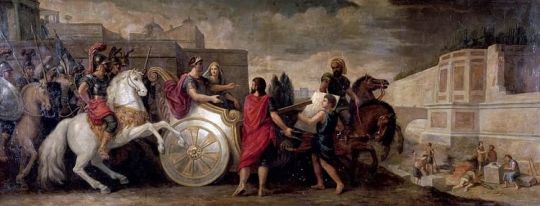
Diodorus Siculus' Account of the Life of Semiramis
Semiramis is the semi-divine Warrior-Queen of Assyria, whose reign is most clearly documented by the Greek historian Diodorus Siculus (l. 90-30 BCE) in his great work Bibliotheca Historica ("Historical Library") written over thirty years, most probably between 60-30 BCE. Diodorus drew on the works of earlier authors, such as Ctesias of Cnidus (l. c. 5th century BCE).
Ctesias (whose works only exist now in fragments) was ridiculed for inaccuracy by other ancient writers, but his accounts are treated as reliable by Diodorus who cites him without reservation.
While modern historians are divided on whether an historical personage named Semiramis ever lived, Diodorus presents her life as a straightforward biographical account of the reign of a great Assyrian queen. As there is only one known queen in the history of Assyria, the regent Sammu-Ramat (r. 811-806 BCE), Semiramis has been identified with her since the 19th century, when archaeological excavations began to uncover Assyrian cities and decipher ancient Mesopotamian inscriptions.
Diodorus' Storytelling
Diodorus does not concern himself with when, or even if, such a queen lived and devotes his energies instead to telling the epic tale of an intelligent, beautiful, and clever queen who rose from humble beginnings to rule all of Mesopotamia, Anatolia, and Central Asia. It seems clear that he borrowed certain events in Semiramis' life from other tales, whether historical or mythical, but this does not seem to have concerned him as long as the story was a good one.
An example of this in the text below is Semiramis' invasion of India, which is very similar to that of Alexander the Great. In 327 BCE, Alexander invaded India with his army, and one of his greatest challenges at the Battle of the Hydaspes River (also known as The Battle of Jhelum) in 326 BCE was the war elephants of King Porus of Paurava. Diodorus, in his account of Semiramis' invasion, could not realistically give her army elephants and so, it is thought, he added in the story of the make-believe elephants to even the odds on the field and make for a better tale. Diodorus' addition of the fake elephants, however, is an example of what makes his works so interesting to read: he never seems to have allowed the truth to get in the way of a good story.
Continue reading...
41 notes
·
View notes
Text
Rules of Engagement
I am here to bring myself closer to the people in order to shape my revolution, and generally continue to heal from the trauma that is my life.
I'm willing to talk about/RP pretty much anything: konoha, its citizens, the ninja world, the non-ninja world, my family, history, furries, whatever. Keeping in mind I'm not trying to be overly serious, and almost all of my posts will be for the sake of humour (that doesn't mean there won't be kernels of truth in what I say). You can ask me about my opinion on these things through my ask or on posts. If you want to say something privately to me you can message me, but don't lead in with something like "hi" only and wait for me to respond (I'll ignore it because I'll assume you're a BBW MILF in my area or something).
I'm not going to talk about anything inflammatory or requires serious thought on greater world topics as I feel that's inappropriate (eg. I won't talk about ongoing wars in specifics). If I see you reblogging my posts in what I feel is an overly antagonistic way, towards myself or others (the most common form of this is I write a post saying I don't like someone, and someone reblogs with "YEAH fuck [female character] she's a [vulgar misogynistic slur] #[female character's name]"), I'll block you. This is meant to be a restorative account to make me and others feel good.
In terms of roleplaying:
I'm okay with interacting with anyone, but if I don't know who you are please forgive me and I'll ask you to introduce yourself
I'm always "in character" even in DMs, it's just easier that way for me
I use emojis and gifs to communicate actions and expressions sometimes, it's just more comfortable for me that way as it's easier for me to communicate visually
If you're someone who should be dead/disappeared/whatever in canon, the feelings I would have towards you will remain as they should. If you want to discuss a storyline on this, let me know.
I know some roleplayers type story-like things with each other (closed RPs? starters?), I won't do that because I just don't have the energy for it. If you wanna go through a certain situation with me just bring it up in a post you tag me in or inbox me and I'll respond!
I talk about sasunaru primarily since this is a canon-ish blog, but I'm open to alternate stories so long as they develop naturally.
A reminder that everything I post is from my perspective and based on my opinion. FYI I see the Naruto manga as a biographical re-telling of certain events (everything until chapter 699), and the anime as an interpretation of the biography (therefore some filler will be true to me). Therefore, any time I present thoughts on these things, they may not always be 100% in line with what's shown-- basically this blog is semi-canon divergent.
Feel free to add to my posts in disagreement but I might not respond. If I annoy you or you consistently take issue with something I say, block me for your own sake. If I said something to upset you and you don't want to block me, you can just tell me and I'll 99% apologize, but 100% address it with respect.
That being said, I'm here to have fun-- that is the best revolution.
ETA 24/04/24: you can follow me on letterboxd if youre interested, i'll follow back and you can send me movie recs or anon hate about my movie opinions in my inbox here, i pretty much watch anything recommended to me but i'll be honest about what i think of it
#i'll edit this as things change#announcements:#sasuke rp#sasuke uchiha#im feeling wannaone - energetic so i want to talk to more people#uchiha sasuke#sasuke#thats me#the vast majority of interaction ive already had
20 notes
·
View notes
Note
just to chime in on the ethel discourse, I was a casual fan for a while. I didn't really listen to her music much itself but I was a fan of her southern gothic aesthetic posts via mother-cain and enjoyed her lyrics via lots of fandom edits and web weaving. I mainly knew her through various gothic incest girl horror fandoms. I wasn't under the impression that she was necessarily sharing her abuse trauma or believe that you have to have the trauma to write about dark content, but her positioning, at least seemingly on her blog/tumblr presence, was absolutely that she grew up poor and struggling and that she was using like, exaggerated terms about her experiences in her writing making ethel semi-biographical instead of a completely separate character. I even assumed that that was why she was so ready to go to tankie doomerism, growing up without and feeling left behind by the middle class. Finding out that the ethel persona doesn't have much if anything to do with hayden's actual experiences made me feel tricked and basically erased my sympathy tbh.
ok well if that's the case than ughhhh. like she really could have just been like "here is a fictional story" but she had to pretend its about her in order to get more clout. ugh
7 notes
·
View notes
Text
i kind of want to complain about specific shit from my job on here but i'm afraid i'll be just like these people who want to publish their DnD sessions as the most imaginative story, or comedians who make semi-biographical adult cartoons based on their life experiences.
9 notes
·
View notes
Note
#14 for warden/hawke/inquisitor: who are they closest to from their family?
hawke answered here!
ailill - being a nervous and not very social kid he spent a lot of time growing up with ashalle, fully considering her his mother moreso than a caretaker. i feel like she'd be the type to not only happily listen to aimless childish ramblings about imaginary stories or what bugs he saw that day but also remember the characters' names and ask questions. he felt she took him seriously in a way other adults didn't, considered him just as capable as the rest of his cohort, which made her finally relating his parents' story feel like another betrayal, like she never actually thought he could handle it. otoh he does manage to fully forgive her emotionally as well as logically which he can never bring himself to do for most of the rest of the clan
also extremely close with tamlen and merrill but less in a familial way than friend/peer/messy young adult emotions way lol
annan - they were closest to their spouse, cyrus, who was the first to clan lavellan before his death. annan wasn’t born to the dalish but joined after the clan helped them escape exploitation, and cyrus was the one to whom they largely credited their survival. partly due to traumatic events in their upbringing they’re very reticent to share with anyone any sort of vulnerability, including everything from their true emotions and opinions to objective biographical facts about their life, but by virtue of having witnessed and helped them through some of their worst moments cy was an exception. annan was well-liked and had many close relationships within the clan but he was the one they shared everything with and trusted implicitly, and the two had a deep ‘been in a life or death situation together and saved each others’ lives’ type of bond. they were married for about ten years. after his death annan was semi-possessed by a spirit of vengeance and became closed off emotionally to pretty much everyone, isolating themself by keeping their grief very private and close
#ailill mahariel#annan lavellan#my ocs#asks#talkin#kind of imperfect mirrors to each other now that i think abt it#ailill had an arguably good upbringing and had something terrible to him in the inciting events of dao#annan had a very difficult upbringing and had an arguably good thing happen to them in the inciting events of dai#not that becoming inquisitor was all good by any means but it gave them a way to channel their buried emotions into something productive#(world politics hostile takeover)
9 notes
·
View notes
Text

Ted Lasso S3E6, Sunflowers. A friendly match takes the team to Amsterdam, where one night out unlocks truths for many.
Or, from sunflowers to Wilde to Whitman to Van Gogh and back to sunflowers once again.
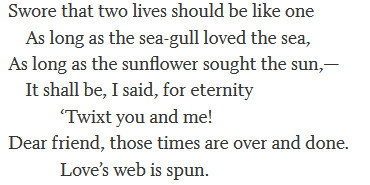
Her Voice
"Oscar and sunflowers are a valid conjunction because perhaps no figure in history has been associated with a single flower as closely as Oscar Wilde was associated with the sunflower in 1882, when he visited the flower’s native America for the entire year." (Oscar Wilde’s Reception in Kansas and the Sunflower Soirée)
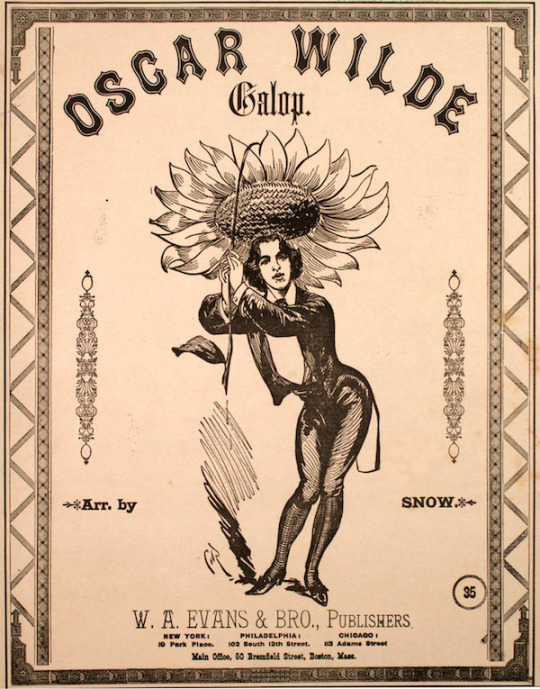
"Manufacturers of household items such as wallpaper, paint, and thread created thousands of business cards depicting Wilde in a variety of poses and postures, typically with sunflowers and lilies, the flowers that became his hallmark — he became known as 'The Sunflower Apostle.'" (The Wilde Woman and the Sunflower Apostle: Oscar Wilde in the United States)
Wilde has been mentioned in relation to Ted Lasso before in this interview with James Lance.
Regarding Oscar Wilde, is there any work of his that you would like to be in, any plays or any of the stories of his or even like a you know biographical thing — anything of his that you would like to to be involved in?
I don’t know — all I know is that the most interesting bit of Oscar Wilde’s material that I’ve read so far is the transcript to the court case, the trial, when he got sentenced. I think his last words were as he was walking out the door, “Is there nothing more I can say,” as he was being shunted downstairs for two years hard labor, which was ultimately kind of a death sentence.
Which is the interview that gave us:

In addition, there is a program of one of Wilde's plays in the Van Gogh Museum.

Theatre programme for Raphaël by Romain Coolus and Salomé by Oscar Wilde (Théâtre de l'Oeuvre, 11 February 1896) in the Van Gogh Museum, Amsterdam. In Sunflowers, there will be many truths unlocked.
“The truth is rarely pure and never simple.” ― Oscar Wilde, The Importance of Being Earnest
No reporters were invited to witness the meeting between Whitman and Wilde. This was a strange choice for two dandyish men who loved self-promotion, but it was a canny one: they would each give separate interviews afterwards, and double the attention they received. In the two hours they’d spent together, both said they’d had a very pleasant time. “One of the first things I said was that I should call him ‘Oscar,’“ Whitman told a reporter afterwards. “’I like that so much,’ he answered, laying his hand on my knee. He seemed to me like a great big, splendid boy.” When Wilde Met Whitman. (and also, A Wilde and Whitman One Night Stand?)
'"Be Curious, Not Judgmental" ― (Not) Walt Whitman. Quoted by Ted during the dart game in season 1.
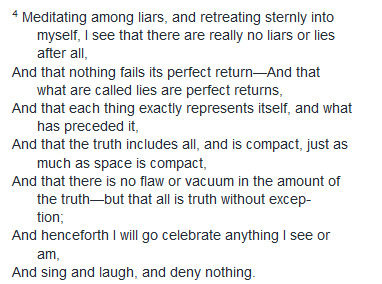
All is Truth.

In 1888, Vincent Van Gogh wrote of Whitman in a letter, “He sees in the future, and even in the present, a world of healthy, carnal love, strong and frank- of friendship- of work- under the great starlit vault of heaven a something of which after all one can only call God- and eternity in it’s place above this world.” (Traces of Whitman in Van Gogh’s “The Starry Night”)

Sunflowers, study (F377), Oil on canvas, 21 x 27 cm, Van Gogh Museum, Amsterdam.


Venus False Sunflower has masses of beautiful yellow daisy flowers with gold eyes at the ends of the stems from early summer to mid fall, which are most effective when planted in groupings. The flowers are excellent for cutting. Its serrated oval leaves remain green in color throughout the season.

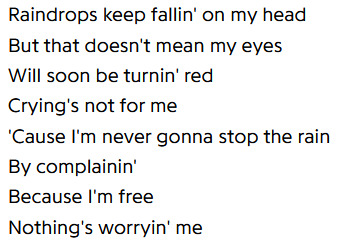
Many consider Sundance Kid to be the oldest dwarf sunflower. The small plant reaches a maximum of two feet, and it has semi-double leaves that are red and yellow, with a small brown disc in the middle. Sundance Kid flowers early and is easy to grow. It continues to flower longer than most sunflowers, allowing you to enjoy the beauty they add to your home for a longer time.
“The sunflower is mine in a way.” ― Vincent van Gogh
#ted lasso#ted lasso meta#ted lasso spoilers#ted lasso sunflowers#tedpendent#trent crimm#the sunflowers are now queer coded and i coded them#im VERY shaky eyes at all of this#AND they are kansas' state flower#and so much more AH#brain go brrr#the dots are all there im sorta leaving them there to be connected but like cmon look at them#LIKE
101 notes
·
View notes